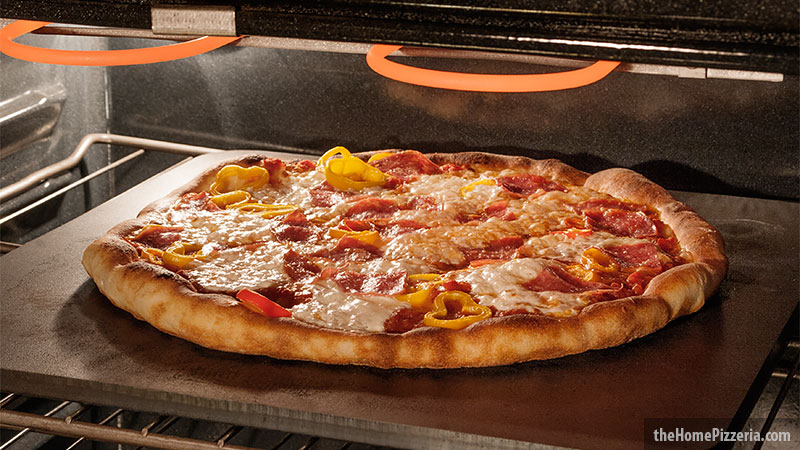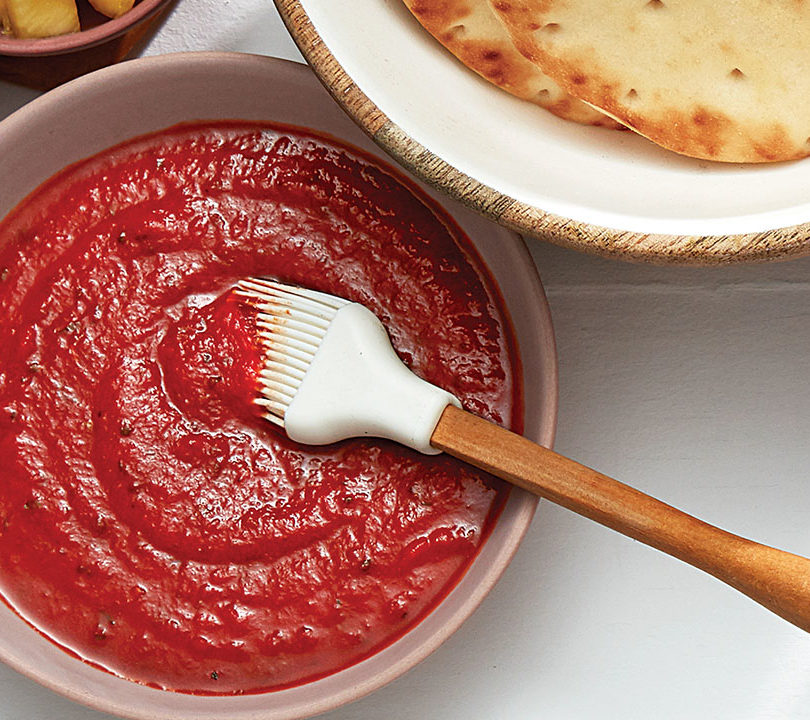There is no such thing as a perfect homemade pizza recipe. But there are some nuanced actions that will take your pizza-making game up a notch or two! By reading this article, you will learn to make the most delicious pizza from scratch without overthinking the recipe.
Here are some essential pizza-making tips and tricks to help you elevate your pizza game.
Don’t over-knead the dough
It’s easy to over-knead the dough. When this happens, it makes the dough hard and difficult to stretch into bases. The best way to describe an overstretched dough is that it has an almost velvety texture and is almost impossible to stretch into a pizza shape. This is because the gluten has been over-strengthened.
This is why it’s important to be extra mindful when kneading the dough. Especially when using a stand-mixer.
Ideally, it is best to use your hands when kneading. You’re able to get a better feel when the dough is ready. However, a good stand-mixer can work well too. Just be careful not to over-knead.
Take your time with proofing the dough
It is important to make the pizza dough ahead of time. Proofing is important for the formation and flavor of the dough. Essentially, it is the process of converting yeast from sugar and glucose to carbon dioxide and alcohol. To get that perfect flavor and crisper crust we can’t rush this process. Ideally around 72 hours. 24-hour rising period and then a 48-hour period to cold ferment.
Cold ferment will add taste and flavor
Fermentation is the core of making the perfect pizza dough. It is essentially the process where larger molecules are broken down into smaller molecules via anaerobic respiration. This process is used for making beer, yogurt, cheese, and bread. Another way to describe the process is yeast being used to digest carbohydrates and convert them to alcohol and carbon dioxide.
The warmer the dough, the faster the yeast will multiply and produce carbon dioxide. This process can be complete in a few hours and you have your dough ready. But, the odds are that it will taste flat and one-dimensional rather than that rich and slightly sour taste you get from a fully optimized dough.
This process adds amazing flavors to your dough, this is done by slowing down the activity of the yeast. This can only be done by refrigerating for at least 1 day (can be done up to 10 days).
The guys at Serious Eats did an experiment on this exact topic. A large batch of pizza dough was made, placed in a proofing container, and was allowed to cold-ferment in the fridge for up to 10 days. Each day, a 6-ounce chunk of it was taken out and formed into a ball. It was then proofed at 70 degrees for 2 hours before being stretched into a 10-inch pizza base and baked on a skillet using the Neapolitan method.
The main takeaway from this was that the optimal time to cold ferment the dough in order to get the best texture and flavor is between 3 to 5 days. 1 – 2 days leaves a flat and one-dimensional flavor. Beyond 5 days will start seeing a drop in the flavor. By the 10th you leave a sour taste. There are other sources that also back this method.
Use a scale
Getting the measurements right differentiates the pros from the rookies. It can be easy to mess up a recipe by measuring by volume. How much a cup weighs can vary depending on how the flour is packed or fluffed. At least when measuring by weight, you get more accurate estimations, regardless of how the flour has been packed.
This is why a scale is an important investment. It will ensure you’re getting the most accurate estimations for your dough.
In terms of the best scale, we would recommend either the Ooni Dual Platform Digital Scales, which is designed for making the most optimal dough.
Learn to use the metric system and baker’s percentages
In relation to scales, it is advised that you know the metric system and baker’s percentages. As we discussed, weights > volume. Therefore, always measure by weights.
Another thing to bear in mind is that not all weight systems are accurate. It is more accurate to measure weight in grams rather than pounds.
Most pizza or baking books have recipes written as ‘formulas’ using grams or kilograms. Ingredients are listed with a percentage next to them. This is the language that bakers use. This is what we mean by ‘Baker’s Percentage’.
In order to understand it, forget how you learned percentages in school. Here are some basic rules:
- It is not the combined weight of the ingredients.
- Any flour you use should always be the benchmark. This means that flour should always be 100% of the formula.
- In an instance where you have 1000g of flour, 700g of water, 10g yeast, and 20g salt. The baker’s percentages would look like flour (100%), water (70%), yeast (1%), and salt (2%).
The illustration below explains it well. To learn more about baker’s percentages check the Introduction to Baker’s Percentages by The Perfect Loaf. Also check this article too.
Picking the right flour goes a long way
The flour used for pizza will affect the dough. Having the choice of flour depends on the type of crust you are after. Whether you’re after a New York or Napolitano-style pizza, it is important to understand that different flours will produce varying styles of pizza.
Different styles of flours will behave differently when being used. Each having their own styles of crust and flavour.
When trying to pick the right flour, it is important to understand the role of gluten. Gluten is a protein that makes the dough all chewy and elastic when wet. The amount of gluten varies with different types of flour. For example, cake and pastry flour are known as ‘soft’ because of the very little amount of gluten they contain. Whereas bread flour has a higher amount of gluten making it a ‘hard’ flour. The chewiness of the gluten makes it ideal for pizza dough.
When choosing the right flour for your pizza dough there are 3 types that stand out.
All-purpose flour
All-purpose flour has lower gluten content compared to other types. Meaning that the dough won’t rise as high as dough from flours with higher gluten content. This makes all-purpose flour great for thin-crust pizzas. Due to its lower gluten content, it can tear more easily making it harder to stretch.
Bread flour
Bread flour is also a very popular choice for making pizza dough. Compared to all-purpose, it has a higher gluten and protein content – allowing it to stretch and rise more. Bread flour is ideal for those who like a soft and fluffy base with crispy edges. Dough from bread flour is easier to work with because the gluten stretches without tearing.
This can also work against you because it’s stretchy nature can add a springy effect by making the dough revert back to shape after being stretched out. The only tip here would be to stretch the dough a bit more than it should be stretched.
Caputo Tipo ’00’ Flour
Caputo Tipo 00 is our pick for making pizza that’s approved by the True Neapolitan Pizza Association (TNPA). The TNPA governs the regulation for true Neapolitan pizza. Caputo Tipo is high in gluten content and proteins making it stretchy and elastic. In addition, the crust gets very crispy when baking. If you’re serious about making homemade pizza to mimic the pizzerias of Southern Italy, Caputo has to be the number one choice. It might be more expensive, but it is also made for making pizza dough.
Use a baking steel
Most home ovens have limitations on their maximum temperature. This means that homemade pizzas don’t get the full optimized temperature that a brick oven pizza would get. To get a crispy and flavorsome crust, it needs that intense heat over a brief period of time.
What makes these pizzas in pizzerias so crispy and flavorsome is the heating surface. To achieve that same effect at home you need a pizza oven or an intensively heated surface.
Not everyone has space or budget for a pizza oven. This is where good pizza steel or baking stone comes to the rescue. Baking steel or baking stone both radiate an intense amount of heat, up to almost 600 degrees. This is enough to overcome the limitations of a home oven which heats up to 450 / 500 degrees.

Learn to stretch the dough with your hands
The reason to stretch is that, after all those hours and days of fermenting the dough, it is filled with little pockets of gas. When baking the dough, these pockets will expand to create that crispy bread-like crust with the most amazing flavor. A rolling pin closes all those gaps.
Make sure the dough is at room temperature before you start stretching. This means making sure you take it out of the fridge, 2 to 8 hours before stretching. The video below really breaks down how to stretch your dough, Neapolitino style!
Can’t stretch? Use a pin
Okay, so you tried your best to stretch and just don’t have the knack for it. Don’t worry, not everyone is meant to be a pizzeria chef. Also, there’s no shame. It is still possible to make great homemade pizza without stretching with your hands (just don’t tell that to a pizza snob).
Rolling pins are perfectly fine for anyone starting out who just want to get stuck in and bake some pizza.
Keep the sauce simple
When making a classic Italian-style pizza, the pizza sauce is a very important ingredient.
In the order to make the perfect pizza sauce, I prefer keeping things simple. All you need are canned tomatoes (preferably San Marzano). Alternatively, you can also make the pizza gravy with fresh tomatoes. Simply blanch the tomatoes in boiling water for 30 seconds, then peel and chop them. Make sure you have some olive oil, garlic, salt, and pepper to hand.
The next step is to heat the olive oil in a saucepan over medium heat. Add the garlic and cook until golden brown. Add the canned or chopped tomatoes and break them up with a wooden spoon. Season with salt and pepper, then bring to a simmer and cook for 30 minutes (minimum).

Don’t go overboard with the pizza topping
This one is subjective. But don’t go overboard with the toppings. Sometimes I see people having pizzas that contain too many toppings. The pizza is littered with onions, pepper, tomato, sweetcorn, sausages, jalapenos, etc.
A truly authentic Italian pizza should ideally aim for 2 to 4 toppings max. Every time you add new toppings, ask yourself whether this extra topping is adding to the pizza or not. Again, this is just an opinion, so go ahead and put some pineapple slices on your pizza if it makes you happy.
Heat that oven up
When baking your pizza, make sure you max out the oven temperature. This is the only way you will get that delicious crispy crust and chewy middle. A brick wall pizza oven can heat up to 800°F or more. Most home ovens can generally go up to 500°F.
In an ideal world, we strongly recommend a good pizza oven. Ooni makes the best pizza ovens at affordable prices. But if you don’t have space, the second-best alternative is some baking steel or pizza stone with a fully heated oven or using a cast-iron skillet.